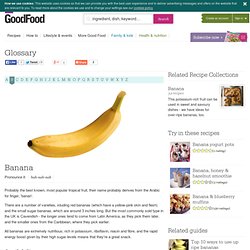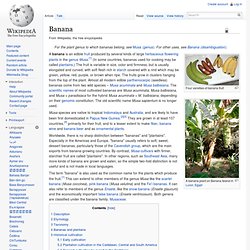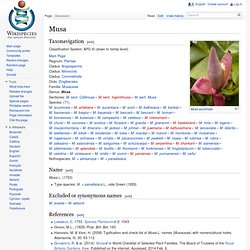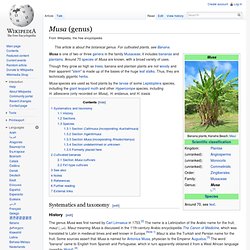

Musa balbisiana. Musa acuminata. Bananas. Wonderfully sweet with firm and creamy flesh, bananas come prepackaged in their own yellow jackets and are available for harvest throughout the year.

The banana plant grows 10 to 26 feet and belongs to the Musaceae family of plants along with plantains. The cluster of fruits contain anywhere from 50 to 150 bananas with individual fruits grouped in bunches, known as "hands," containing 10 to 25 bananas. Banana, fresh1.00 medium(118.00 grams) NutrientDRI/DV This chart graphically details the %DV that a serving of Bananas provides for each of the nutrients of which it is a good, very good, or excellent source according to our Food Rating System. Health Benefits. Banana. Probably the best known, most popular tropical fruit, their name probably derives from the Arabic for finger, 'banan'.

There are a number of varieties, inluding red bananas (which have a yellow-pink skin and flesh) and the small sugar bananas, which are around 3 inches long. But the most commonly sold type in the UK is Cavendish - the longer ones tend to come from Latin America, as they pick them later, and the smaller ones from the Caribbean, where they pick earlier. All bananas are extremely nutritious; rich in potassium, riboflavin, niacin and fibre, and the rapid energy boost given by their high sugar levels means that they're a great snack. Availability All year round. Choose the best To eat straight away, go for bananas with very small patches of black on the skin - that means they're ripe.
Prepare it Just peel and slice or mash. Store it In a fruit bowl. Cook it. Banane. Probablement originaire de la région indo-malaise, le bananier est introduit à Saint-Domingue en 1516.

De là, il gagne tout l’arc caribéen. C’est l’amélioration et l’hybridation de 2 espèces sauvages à graines ( M. acuminata (AA) et M. balbisia (BB)) qui a permis la création des diverses variétés de bananes connues dans le monde. Le bananier, herbe géante, étale son panache de grandes feuilles vert pâle jusqu’à 8 m de haut en fonction des variétés. L’inflorescence, long épi pendant, porte des bractées rougeâtres sous lesquelles se cache une rangées de fleurs. Aux fleurs succèdent une ‘main’ ou ‘patte’ de 3 à 20 bananes. Bananas. Main Page - Bananas Wiki. Bananas.org - International Banana Society. Plantain. All modern plantain cultivars have three sets of chromosomes (i.e. they are triploid).

Many are hybrids derived from the cross of two wild species, Musa acuminata and Musa balbisiana. The currently accepted scientific name for all such crosses is Musa × paradisiaca.[5] Using Simmonds and Shepherds' (1955) genome-based nomenclature system,[6] cultivars which are used cooked often belong to the AAB Group, although some, like the East African Highland bananas, belong to the AAA Group, and others, such as Saba bananas, belong to the ABB Group. Plantains are a major food staple in West and Central Africa (Cameroon & DR Congo), Central America, the Caribbean Islands and northern, coastal parts of South America (Colombia, Venezuela, etc.).
Their attractiveness as food is that they fruit all year round, making them a reliable all-season staple food. Description[edit] An average plantain has about 220 calories and is a good source of potassium and dietary fiber.[8] Banana. Four varieties of banana fruit Worldwide, there is no sharp distinction between "bananas" and "plantains".

Especially in the Americas and Europe, "banana" usually refers to soft, sweet, dessert bananas, particularly those of the Cavendish group, which are the main exports from banana-growing countries. By contrast, Musa cultivars with firmer, starchier fruit are called "plantains". In other regions, such as Southeast Asia, many more kinds of banana are grown and eaten, so the simple two-fold distinction is not useful and is not made in local languages. The term "banana" is also used as the common name for the plants which produce the fruit.[1] This can extend to other members of the genus Musa like the scarlet banana (Musa coccinea), pink banana (Musa velutina) and the Fe'i bananas. Description A banana corm, about 25 cm (10 in) across The female flowers (which can develop into fruit) have petals and other flower parts at the tip of the ovary (the ovary is "inferior"). Etymology Taxonomy.
Musa. [edit] Classification System: APG III (down to family level) Main Page Regnum: Plantae Cladus: Angiosperms Cladus: Monocots Cladus: Commelinids Ordo: Zingiberales Familia: Musaceae Genus: Musa Sectiones: M. sect.

Callimusa – M. sect. Ingentimusa – M. sect. Name[edit] Musa L. (1753) Type species: M. × paradisiaca L., vide Green (1929) Excluded or synonymous names[edit] M. ensete – M. wilsonii References[edit] Musa (genus) Musa species are used as food plants by the larvae of some Lepidoptera species, including the giant leopard moth and other Hypercompe species, including H. albescens (only recorded on Musa), H. eridanus, and H. icasia.

The genus Musa was first named by Carl Linnaeus in 1753.[2] The name is a Latinization of the Arabic name for the fruit, mauz (موز). Mauz meaning Musa is discussed in the 11th-century Arabic encyclopedia The Canon of Medicine, which was translated to Latin in medieval times and well known in Europe. [Note 1] Mauz is also the Turkish and Persian name for the fruit. Some sources assert that Musa is named for Antonius Musa, physician to the Emperor Augustus.[3] The word "banana" came to English from Spanish and Portuguese, which in turn apparently obtained it from a West African language (possibly Wolof).[4] Food served on a banana leaf, a traditional way of serving food more popular in southern India Fruit stalk of Musa sp. Banana flowers M. ingens N.W.Simmonds.